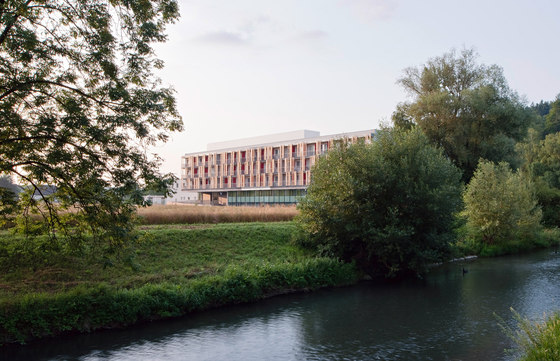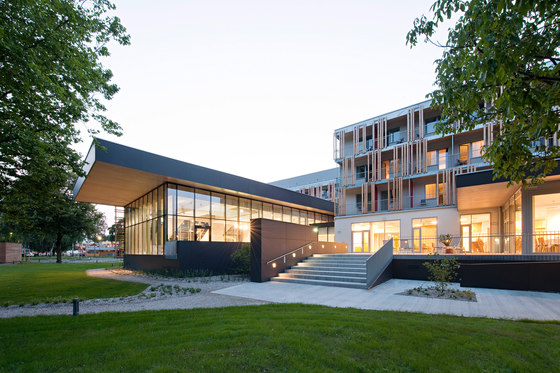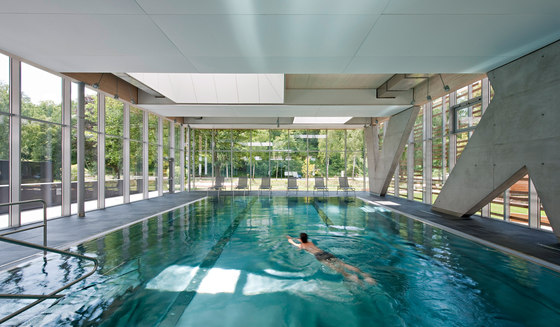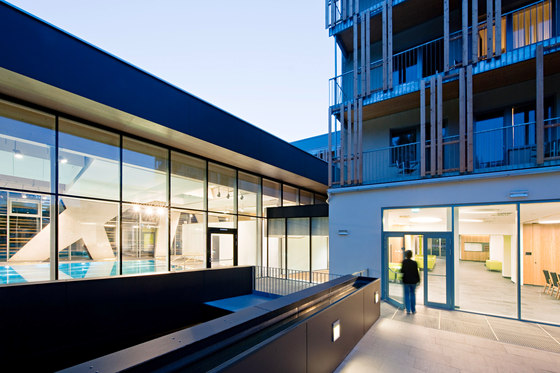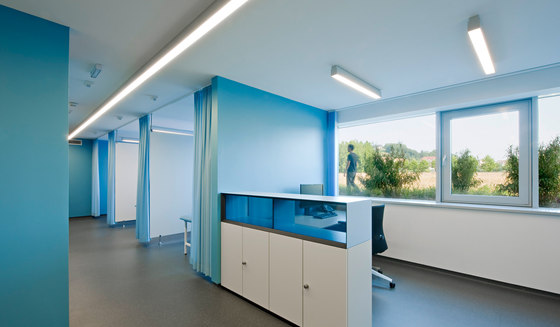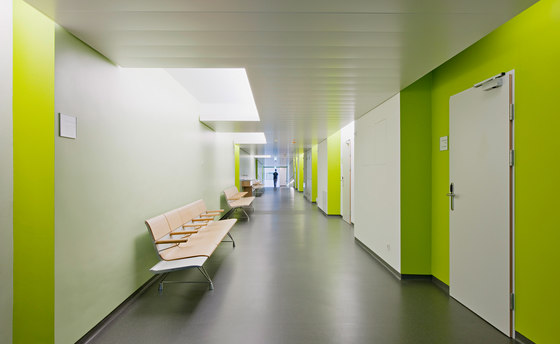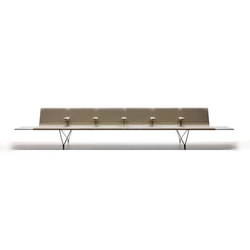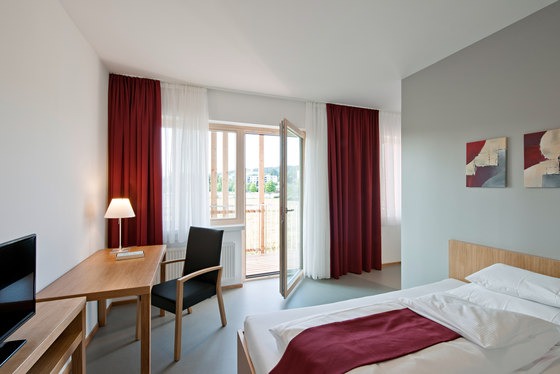An inviting rehabilitation center highlighting maximum comfort and low operating costs are the result of a comprehensive renovation, modernization and extension of the healthcare facility Bad Schallerbach by the Health Insurance Fund for Railway- Workers and Miners (VAEB). After a construction period of 20 month the new center combines medical care facilities in a spa like setting and sets new standards in energy efficiency and healthcare.
As part of a comprehensive restructuring plan, the VAEB embarked on a massive upgrade and development of the property situated directly on the bank of the River Trattnach. Architects Collective was chosen from an EU-wide competition to work on the reconstruction. The renovation and extension of the health care facility includes an addition of 124 guest beds and upgrades to the surrounding park. In the course of planning, the five-story building built in 1968 was reorganized with the addition of 6,000 square meters and complete thermal renovation. Additionally, the architects created a 4,200-square-foot extension with a hotel rooms, therapy area, pool and dining room.
A lot of light and natural materials
Die Bad Schallerbach VAEB combines a visionary concept based on a harmonious exchange between health, nature and human ecology. This exchange is emphasized throughout the building via its spatial references to the surrounding natural environment and use of natural materials throughout. The therapy pool, with its dramatic cantilevered roof to the south serves as the heart of the facility. From there, the interior space flows out to the surrounding park updated with inviting new seating areas shaded by old birch/oak trees. The fluid transition between the interior and exterior of the building represents a symbiotic relationship between medicine and nature. The interior emphasizes natural surfaces including slate, stone and rubber floors as well as furniture made of light oak has been imbedded with fresh hues that lend the healthcare facility a resort like quality. Color accents varying from floor to floor serve as a discrete navigational system for guests. The friendly and open character of each space is enhanced by strong visual links between the lush park and foyer, living areas and therapy pool. Due to the repetitive floor plan in the areas of accommodation, wood in the form of highly insulated exterior walls and solid wood panels inserted between partition walls and ceiling serve as the ideal building material. The balconies of the newly renovated areas are made of wood and a lightweight steel construction and have been outfitted with irregular wooden slates offering guests shading and visual protection. The majority of the new construction is prefabricated with different factory-fitted parts such as entire walls or ceiling elements of the health care facility.
Promoting Health
The VAEB will reduce its number of healthcare facilities from nine to four as part of a larger restructuring plan. As a result, Bad Schallerbach is the first investment of the VAEB that meets the requirements of a modern healthcare center. In addition to a weight-loss program, the facility also focuses on prevention and health promotion via a three-week stay program emphasizing a holistic approach to therapy and health benefits. The basis for this multimodal treatment and prevention approach is supported by appropriate medical recommendations supported by an attractive setting with ongoing reference to nature. The aim is to increase or maintain personal health care, activity and working ability, which will ultimately reduce the cost of treatment or care. The healthcare facility Bad Schallerbach exemplifies a new health concept by creating the future requirements of the insurance company.
Energetic-Thermal Renovation
The Climate and Energy Fund of the Federal Government financially supported the renovation of the building, thus supporting a number of additional qualitative and energy measures. These include the replacement of all the windows of the existing building, the switch to green electricity and improvement of home automation systems. As a result, the entire building has the status equivalent of a low-energy building and is as an active certified building which means minimal operating costs and maximum comfort. According to OIB, Guideline 6 had to be reduced by a minimum 50 percent in order to achieve heating and cooling requirements. The total energy requirement of the renovated building had to be at least 35 percent lower than the sharing of renewable energy sources or waste heat from unused potentials. Both parameters were significantly below this level.
Klima:Aktiv „Silver“
The building’s extension and renovation, thermal rehabilitation and resource-efficient planning and execution set new standards for comparable facilities. In Austria alone, over 100 such facilities must be restored within the next few years. Despite a limited budget for building costs, it was possible to improve the building’s heating requirements by 87 percent in the treatment and accommodation areas. This represents a fall below the legally required value of 65 percent. The building’s cooling requirements were also improved by as much as 82 percent. The architects were able to achieve this by improving the compactness of the building, consistent thermal insulation of walls and roof surfaces and eliminating thermal bridges through the demolition of minor building parts. All windows and glass surfaces were designed as Ug 0.7 W/m2 K and all rooms are equipped with controlled ventilation and efficient heat recovery supported by hot water collectors on the roof. Various criteria is assessed and evaluated by a neutral party including; active building standards, energy efficiency of planning and quality of execution, the quality of building materials and construction, as well as key aspects related to comfort and indoor air quality.
Versicherungsanstalt für Eisenbahn und Bergbau (VAEB)
Architect: Architects Collective ZT-GmbH (AC)
Team (AC): Andreas Frauscher, Richard Klinger, Mathias Lang (Projektleiter), Harry Leuter, Valentina Petrovic, Kurt Sattler (Partner-in-Charge), Thomas Spindelberger, Fei Tang
Generalplaner: Arge GBS (AC/Nuhsbaumer/Palme)
Fachplaner:
HKLSE: Ing Peter Palme GmbH
Tragwerksplanung: Gmeiner Haferl ZT-GmbH
Lichtplanung: Fourth Minute GmbH
Küchenplanung: Vertec GmbH
Grünraumplanung: Weidlfein Gartenkunst
Brandschutzplanung: Auctor GmbH
Project team:
Projektsteuerung: SVD GmbH
Begleitende Kontrolle: Ingenos Gobiet GmbH
Örtliche Bauaufsicht: TB Landauer GmbH
